![]()
![]()
![]()
Use LEFT and RIGHT arrow keys to navigate between flashcards;
Use UP and DOWN arrow keys to flip the card;
H to show hint;
A reads text to speech;
123 Cards in this Set
- Front
- Back

What is being shown?
Identify a single cell What can you say about the nuclei arrangements? What is its function? What kind of proteins do they contain? |
-skeletal muscle
-the muscle fiber or muscle cell is the bundle of long, cylindrical striated cell -multinucleated -contraction, movement, & heat -myofilaments (actin & myosin) |
|
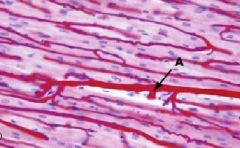
What kind of cells are shown?
What is A pointing to, and why is it important to the cells' function? |
-muscle fibers (muscle cells)
-blood vessels -need rich blood supply since cells are metabolically active |
|

Is this a TEM or SEM?
What is this picture showing? What is the structure labeled with letter M? Locate the glycogen inclusions |
-TEM
-part of a muscle fiber -mitochondria |
|

What type of tissue is shown with large, striated cells in a parallel arrangement
What is unique about the nuclei? |
-skeletal muscle
-multi-nucleated cell; nuclei are located basally |
|

What kind of tissue is this?
What kind of cells? What is unique by the nuclei? Identify the epimysium, perimysium, & endomysium |
-skeletal muscle tissue
-muscle cells -nuclei are located peripherally -endomysium (around individual cell), perimysium (around fascicle), & epimysium (around whole muscle) |
|
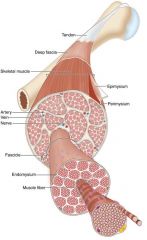
Which connective tissue layer wraps around the whole skeletal muscle?
Which connective tissue layer warps around each fascicle? Which connective tissue layer wraps around individual muscle fibers (elongated mutlinuclear cells)? Identify the myotedinous junctions? |
-epimysium
-perimysium -endomyisum -located right by the tendon; it is where the muscle meets the tendon |
|
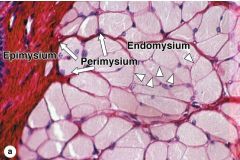
What type of tissue is this?
What do you notice about the nuclei? What do the arrowheads point to? What do all three of these CT layers contain? |
-skeletal muscle
-peripherally -endomysium -collagen types I & III (reticulin) |
|
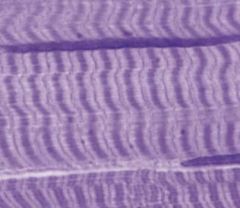
What is shown here?
What structures can you see? Where is the Z line? |
-skeletal muscle striations
-myofibrils: bundles of thick & thin myofilaments -darker Z line located in the middle of the I band |
|

What structure is shown here?
What structure does the blue dot show? What structure does the green dot show? What structure does the red dot show? |
-skeletal muscle striations
-z-line (or disc) -I band (thin) -A band (thick) |
|

What is this structure?
What does the yellow dot show? What does the blue dot show? What does the red line show? What does the green line show? What does the brown line show? |
-sarcomere (z line to z line is smallest contractile unit)
-M line -Z line -A band -H band -I band - |
|

What is shown here?
What is the green line? What is the yellow line? What is the red line? What happens to the overlap during contraction? What happens to the overlap during relaxation? |
-myofilaments: skeletal muscle striations
-dark area of overlap: where thick & thin filaments overlap -H band: thick filaments only -I band: thin filaments only -contraction: amt of overlap increases -relaxation: amt of overlap decreases |
|
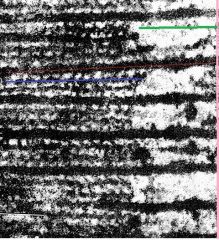
What is shown?
What is the pink line showing? What is the green line showing? What is the brown line showing? What is the blue line showing? |
-myofilaments: striated skeletal muscle
-M line -H band -myosin (thick) -actin (thin) |
|

What is shown?
What is the arrangement of this structure? |
-cross-section view of myofilaments (striated skeletal muscle)
-1 thick filament (larger circle) is surrounded by 6 thin filaments (smaller dots) |
|

What structure is the arrow pointing to?
What is its function? |
-transverse tubules
-invaginations of the sarcolemma, so that when a signal travels into the t-tubules a uniform depolarization causes all the cells to contract at the same time |
|

Which structure is shown in the red arrow?
Which structure is shown in the green arrow? |
-terminal cistern (enlarged portion of ER)
-SR tubules (specialized to store Ca2+ ions) |
|
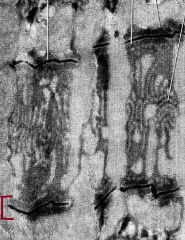
Which structure is enclosed in the red line?
What is it composed of? What is its function? |
-triad
-1 t-tubule surrounded by 2 terminal cisternae -junction of A & I bands |
|

Identify the T-tubule & triads
Identify where the SR is |
-t-tubule is the invagination of the plasma membrane; it has a trilaminar wall
-SR is located right below the upper triad structure |
|

What structure is being shown?
What does it innervate? What are the bulb-like structures at the end of the structure? |
-motor neuron
-can innervate one or more skeletal muscle fibers -terminal boutons |
|

What is this structure of?
What does it innervate? |
-motor neuron
-innervates one or more skeletal muscle fibers |
|

What is the large circle?
What is the structure labeled M? What is the structure labeled SnC? What is the structure MF? |
-motor nerve fiber
-mitochondria -synaptic cleft -muscle fiber |
|
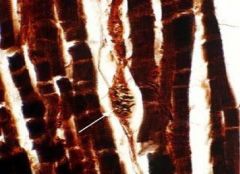
Which structure is shown here?
What is its function? Where are they found? What type of fibers are found in this structure? |
-muscle spindle
-monitors changes in length & tension; participate in stretch reflex -located in actual substance of muscle fiber -contains afferent nerve fibers that senses changes in length & tension in muscle to take info to nervous system |
|

What is shown here?
What is its function? |
-muscle spindle & Golgi tendon organ
-sense tension & can send steps to reduce contraction |
|

What kind of tissue is this?
What is unique about nuclei? Do the structures branch? |
-cardiac muscle tissue
-single centrally-located nuclei (about 20% are binucleate) -yes, muscle fibers branch |
|

Which tissue is shown, and how can you tell?
|
-cardiac muscle cell; can tell by the central nucleus
|
|

What structure is shown?
What is the dark staining structure adjacent to the cardiac fibers? How do these cells attach? |
-cardiac muscle fibers
-intercalated discs -attach end to end |
|

What is the darkly stained structure?
What does it contain? |
-intercalated disc
-fascia adherens (similar to zonula adherens), desmosomes, & gap junctions |
|

What structure is this?
Is this considered regular or irregular? What are the transverse portion labeled D & FA? What is the function of D? What are the longitudinal portion labeled N? What is the function of N? What organelles are abundant here? |
-intercalated discs
-irregular -desmosomes & fascia adherens -resist mechanical force of contracting cells -gap junctions -how adjacent cardiac cells communicate with each other -mitochondria & glycogen inclusions |
|

What cell is shown below?
What is the diad composed of? Why are the t-tubules large? |
-cardiac muscle cell
-1 t-tubule & 1 incomplete terminal cisterna -SR does not store as much Ca2+, so Ca2+ brought in through the t-tubules |
|

Which type of tissue is shown?
|
-smooth muscle
|
|

What type of tissue is the arrow pointing to?
What is its function? |
-smooth muscle
-forms sheets or layers in walls of organs, blood vessels, skin, respiratory passages, & glands |
|
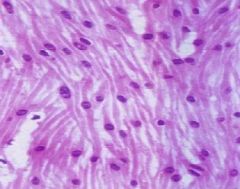
What type of muscle tissue is shown?
Is the cell multi-nucleated or single-nucleated? -fusiform, single central nucleus -Since there are no striations, are there any sarcomeres, actins, or myosins? What type of innervation do these cells receive? |
-smooth muscle tissue
-no sacromeres; yes, have actin & myosin -only 1-2 cells receive innervation from ANS, & the rest of the cells receive from gap junction |
|

What type of cell is shown?
What is the function of dense bodies? What contractile proteins are involved? With a sparse SR & no t-tubule, what is the main mechanism of Ca2+ intake? |
-smooth muscle cell
-act as anchors for actin similar to z line in skeletal muscle -actin & myosin; crisscross pattern facilitates contraction of tubular structures -pinocytotic vesicles via caveolae |
|

What cell is shown below?
What does are the structures for G, Fi, D+J, ER, M, & C |
-smooth muscle cell
-G = gap junction, Fi = actin & mysoin, D+J = dense bodies, ER = SR, M = mitochondria, & C = caveolae |
|

Which structures is the black line pointing to?
What is their function? |
-caveolae
-bring in Ca2+ |
|
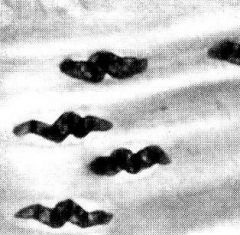
What type of cell is this?
Why is it a corkscrew nuclei? |
-smooth muscle cell
-SM has been contracted |
|

What cell is this?
Is this relaxed or contracted? |
-smooth muscle cell
-relaxed |
|

What cell is this?
Is this cell relaxed or contracted? |
-smooth muscle cell
-contracted |
|

What kind of tissue is this?
How do these cells undergo hyperplasia? How do these cells undergo hypertrophy? |
-smooth muscle tissue
-hyperplasia by mitosis -hypertrophy by addition of contractile proteins |
|

What kind of muscle tissue is this?
|
-skeletal muscle tissue
|
|

What type of tissue is this?
|
-cardiac muscle tissue
|
|

Which type of tissue is this?
|
-smooth muscle tissue
|
|

What system is this in?
What is the green arrow pointing to? What is the red arrow pointing to? What is the black arrow pointing to? Where is the CT? |
-CNS
-neurons (functional cells) -glial cells (supporting cells) -neuropil (axons & dendrites attached to glial cells) -no CT in CNS |
|

What system is shown?
What structure is the star? |
-CNS
-neuropil (axons & dendrites arising & converging upon neurons in the CNS gray matter) |
|

What system is this?
What structure is the star? |
-CNS
-neuropil (axons & dendrites converging upon neurons in CNS gray matter) |
|
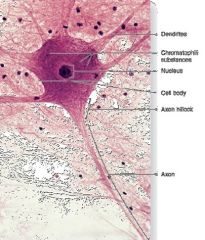
What cell is this?
Where is it found? What is its primary function? |
-neuron
-found in CNS & PNS -generate and propagate action potentials |
|
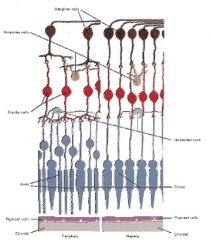
Where is this found?
What are the red cells? |
-retina
-bipolar neurons (1 dendrite + 1 axon) |
|

What type of cell is this?
Which pathways are they found in? How often are they found in the body? |
-bipolar neuron
-auditory, visual, & vestibular (balance) pathways -not frequently found in the body |
|

What type of cell is this?
What are the 2 parts of the axon, and what are their functions? What is the role of the cell body? |
-pseudounipolar neuron (has only 1 axon)
-1) peripheral processing (bring info gathered from dendrites) 2) central processing (found in sensory ganglia to continue processing info) -cell body does not play a role in decision-making; info goes thru peripheral processing, skips the cell body, & continues to central processing |
|

What type of cells are these?
How many axons or dendrites? |
-multipolar neurons (most common type found in the body)
-1 axon + 2 or more dendrites |
|

What types of cells are these?
Where are they found? |
-multipolar neurons
-cerebral cortex (6 layers) |
|

What is the orange arrow pointing to, and what are their functions?
What is the yellow arrow pointing to? |
-dendritic spines; increases surface area
-axon Note: dendrites can change their diameter, but axons do not |
|
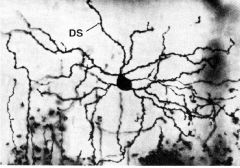
What structure is DS?
|
-dendritic spine
|
|

What type of cell is this?
What is in the Nissl bodies? Where are NT produced? What are other components of cell body? |
-neuron
-RER & free ribosomes -NT created by RER & stuck on the Nissl bodies -neurofilaments, microtubules (for vesicular transport), axons, & dendrites |
|

What are other names for cell body?
What is the red arrow pointing to and what does it contain? What is the yellow arrow pointing to, and what does it contain? |
-soma & perikaryon
-nucleus & euchromatic -prominent nucleolus; contains rRNA that make ribosomes |
|

What is the green arrow pointing to?
What is the yellow arrow pointing to? What is the red arrow pointing to and what is their function? |
-nucleus
-nucleolus -Nissl bodies; contains RER & free ribosomes that make proteins for neurons |
|

What is this TEM showing?
What is outlined in red? What is outlined in blue? |
-cell body
-multiple Golgi complexes -Nissl bodies (RER & free ribosomes) |
|
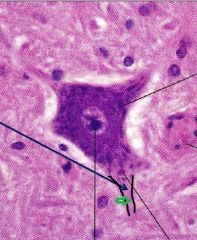
What is the blue arrow pointing to, and what does it contain?
What is the green arrow pointing to, and what happens there; does it have any myelin? |
-axon hillock (contains no Nissl bodies or Golgi); where cytoskeleton & secretory vesicles pass from cell body to the axon
-initial segment; it is between the axon hillock & beginning of myelin sheath; where action potentials are generated; no myelni |
|

What is the green arrow pointing to?
Is there any myelin at this structure? |
-terminal bouton
-no myelin |
|

Which direction is anterograde?
Is this transport fast or slow? Which direction is retrograde? Is this transport fast or slow? What are some examples of retrograde axon transport? |
-travels from cell body to destination
-could be fast or slow (transports cytoskeletal precursors & elements) -travels from destination back to cell body -just fast (utilize microtubules & motor proteins to transport organelles & synapatic vesicles) -herpes simplex, rabies, & polio |
|
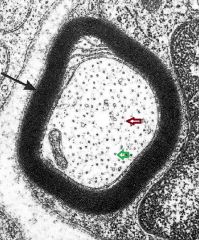
Is this PNS or CNS?
What is the black arrow pointing to? What is the tiny black dot the red arrow is pointing to? What is the round structures the green arrow is pointing to? |
-PNS
-myelin sheath (Schwann cells) aka external lamina -neurofilaments (intermediate filaments of neurons) -microtubules Note: In PNS, one internodal segment on one axon |
|

What is the green arrow pointing to?
What is special about this area? |
-internodal segments
-it is regions where myelin is present (insulated) |
|

What system is this in?
What is the red arrow pointing to? |
-CNS
-white matter (axons) -gray matter (cell bodies) |
|

What is the structure labeled A?
What is the green arrow pointing to? What is the red arrow pointing to? What is myelin made out of? |
-axon
-glial cell plasma membrane that forms the myelin sheath -nucleus of glial cells -phospholipid rich structure |
|
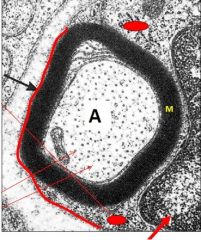
What is the red oval structure showing?
What is the red arrow pointing to? |
-cytoplasm of glial cells
-nucleus of glial cells |
|

What does each line in M represent?
|
-glial cell; each piece of myelin sheath is a glial cell
|
|

Identify myelin
What are the cells that make up myelin in CNS? Locate Nodes of Ranvier |
-oligodendrocytes
-regions where there is no myelination (pale spots) |
|

In this LM section of myelinated nerve fibers, what structure is indicated in the middle of the blue bar?
What is the yellow structure outlining? |
-node of Ranvier
-internodal segment |
|

Where is this located?
What is this a cross-section of? What is the pink dots in the center? What are the pale circles around each pink dot? What is the white part? |
-peripheral nerve
-myelinated nerve fibers -axons -myelin -lipid |
|

What does structure of the star indicate?
What are the structures with the yellow circles? -myelinated or unmyelinated? |
-glial cell nucleus
-axons -unmyelinated Note: axons are enveloped by glial cells, but NOT wrapped by glial cell |
|

What is the pink star showing?
What is the green arrow pointing to? What is the yellow line showing? What is the red arrow pointing to? What is the blue arrow pointing to? |
-mitochondria
-synaptic vesicles -synaptic cleft -postsynaptic density -axon (presynaptic element) |
|

What is the feet on astrocytes called?
What is the role of astrocyte? |
-perivascular feet
-astrocytes help suppoert the blood-brain barrier and the glial limitans (barrier between pia mater & CNS) |
|

What is this stain?
What are astrocytes always found near? |
-silver stain
-blood vessels |
|
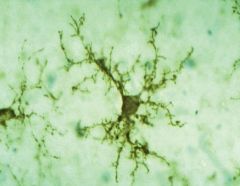
What is this cell?
What system is it found in? What is its function? |
-microglia
-CNS -host cell defense; can become phagocytic & antigen-presenting cells |
|
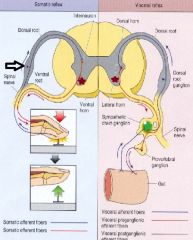
What is the green star?
What are the red stars? What is the black arrow pointing to? |
-motor ganglia (part of ANS); contain motor cell bodies
-somatic cell bodies (part of CNS) -posterior root ganglia (contain sensory cell bodies along with pseudounipolar cells & satelite cells) |
|

What is this a structure of?
What is the structure labeled CT? What is the structure NF? |
-sensory ganglia; posterior root ganglia
-CT capsule -nerve fiber bundles |
|
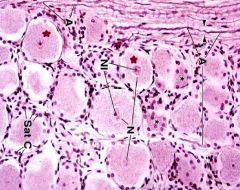
What is this a cross-section of?
What are the cells with red stars called? What are the cells labeled with Sat C called, and what are their functions? |
-posterior root ganglia (sensory ganglia)
-pseudo-unipolar neurons -satelite cells; form a complete ring around pseudounipolar neuron |
|

Where is this located?
What cell is located in the black box? What is different about the organization? |
-motor ganglia (autonomic ganglia)
-mutlipolar neurons (cell bodies) -nerve fibers are less bundled & neuronal cell bodies are more scattered |
|
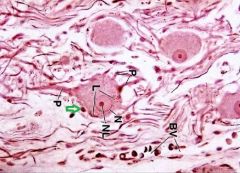
What type of cell is being shown?
Where in the body is this located? What is the green arrow pointing to? |
-multipolar neuron
-motor ganglia (autonomic ganglia) -satelite cells that form an incomplete ring |
|

What is this wavy looking structure shown here at low power?
|
-peripheral nerve (collection of functionally related nerve fibers)
|
|

What is this a cross-section of at low power?
|
-peripheral nerve
|
|

Where is this located?
What structure is the black arrow pointing at? |
-peripheral nerve (higher power)
-nodes of Ranvier |
|

What is shown?
What is the black arrow pointing to (white space)? What is the blue arrow showing? What is the red arrow showing? What is the green arrow showing (surrounding the inside structure)? |
-cross-section of peripheral nerve
-artifact -blood vessel -perineurium -epineurium |
|
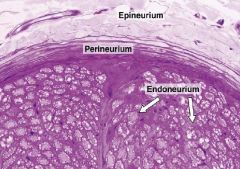
What is this a cross-section of?
What is the role of epineurium? What is the role of perineurium? What is the role of endoneurium? |
-peripheral nerve
-fibrous coat around whole nerve; also fills space between nerve fibers -surrounds each nerve fibers -envelops the myelin sheath of individual axons; composed of reticular fibers produced by Schwann cells |
|

What is this a cross-section of?
What is the black arrow pointing to? What is the red arrow pointing to? What is this yellow star showing? |
-peripheral nerve
-endoneurium -perineurium -epineurium |
|
|
What are the functions of integument?
|
barrier for protection, provides immunological information, conveys sensory information, & performs endocrine functions (vitamin D uptake), excretion of waste products, & thermoregulation (blood flow & sweating)
|
|

What is the top purple stained layer?
What is the middle layer labeled D? What is the last layer labeled SC? What does the last layer contain? |
-epidermis
-dermis -hypodermis aka superficial fascia -contains loose CT w/ fat; not a part of skin layers; fat storage; contains large blood vessels |
|

What is this structure shown?
What is its function? |
-rete apparatus
-bumps that connect between epidermis & dermis |
|

What is this picture showing?
What is its function? What is the yellow star showing? What is the red arrow pointing at? |
-rete apparatus
-attach epidermis to dermis; forms fingerprints (dermatoglyphs) -interdigitations of epidermal ridges -interdigitations of dermal ridges (papillae) |
|

What type of skin is this?
Is this vascular or avascular? How are the cells renewed? |
-thin skin: stratified squamous keratinized epithelium
-avascular -continuously renewed by mitosis (20-30 day cycle) |
|

What type of skin is this?
What are the main characteristics? Where are they found? Is this avascular or vascular? |
-thick skin
-glabrous, smooth, non-hairy; see all five layers of epidermis -palm & soles; places that lack hair follicles/sebaceous glands -avascular |
|

What type of skin is this?
Approximately how many layers? Where is it found? |
-thin skin (hairy)
-3-4 layers of epidermis -found on most part of the body |
|
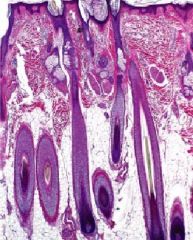
What skin type is shown here?
What are the components of it? |
-thin skin
-hair follicles, sebaceous, & sweat glands |
|

What skin layer is shown?
|
-stratum basale (aka stratum germanitivum)
|
|

What is this layer?
Where do the cells lie? Do these cells have mitotic properties? What layer is labeled D? |
-stratum basale
-basement membrane -yes, they are actively dividing cells (renewed every 15-30 days) -dermis |
|

What layer is shown?
What are the cells labeled BC? What are the main features? What is tonofilaments, and what is its function? What is the structure labeled TF? |
-stratum basale
-basal cells -large nucleus & abundant free ribosomes -tonofilaments that are the intermediate filaments of keratinocytes that are made out of keratin to make cells tough & protect from outside world -tonofibrils (bundle of tonofilaments in stratum basale & stratum spinosum) Note: This layer contains the basement membrane, hemidesmosomes, & desmosomes |
|

What layer is shown?
What is HD, D, L, & F? |
-stratum basale
-hemidesmosomes (between cell & basal lamina), desmosomes (between cells), lamina dense, lamina lucida, & attachment fibers |
|

What are the cells labeled M?
What layer are they located in? |
-melanocytes (associated with skin color)
-stratum basale |
|

What layer is this?
What are the main characteristics? |
-stratum spinosum aka prickle cell layer (above stratum basale)
-multiple cell layers |
|

What layer is this?
What are the main features? |
-stratum spinosum
-see pricks around the cells; cuboidal or slightly flattened cells w/ a central nuclei |
|

What layer is this cell found in?
What is the structure with the red circle called? |
-stratum spinosum
-nodes of Bizzozero: how the cells are bound together by filament-filled cytoplasmic spines & desmosomes Note: desmosomes cause cell to stick together strongly, so they dehydrate & can't completely separate |
|

What layer is this found in?
What is the structure in the blue box? |
-stratum spinosum
-nodes of Bizzozero that contains desmosomes between cells |
|

What layer is this?
What is in the cytoplasm? What are the structures labeled F? What does the middle picture show? |
-stratum spinosum
-contain processes filled with tonofibrils (intermediate filaments - keratin) that terminates in the desmosome -tonofilaments (located above desmosomes) -desmosomes |
|

What cell layer is this?
What are the cells labeled L called? |
-stratum spinosum
-Langerhan cells |
|
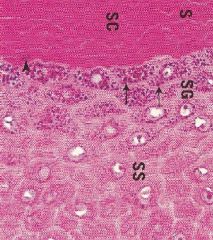
What is the layer labeled SG?
What are the main features? What are the 2 types of granules? What are the black arrows pointing to? |
-stratum granulosum (above stratum spinosum)
-has 3-5 layers of cells; last layer with nuclei; lysosomal enzymes digest organelles -keratohyalin & lamellar granules = bodies -keratohyalin granules that are very basophilic; not surrounded by a membrane; produced by ribosomes |
|
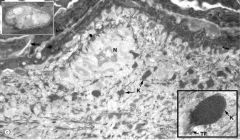
What layer is this?
What are the structures labeled K & TF, and what are their functions? What is the structure on the top left, and their function? |
-stratum granulosum
-K = keratohyalin granules & TF = tonofibrils; keratohyalin is associated w/ tonofibrils to help strengthen them -lamellar bodies that discharge lipid-content; barrier for foreign material; water-proofs the skin; produced in Golgi apparatus |
|

What layer is this in?
What structure is the red arrow pointing to? What structure is the blue arrow pointing to? |
-stratum granulosum
-keratohyalin granule -lamellar bodies |
|

What layer is this?
What kind of skin is it located in? What are its main features? |
-stratum lucidum
-thick skin only -no nuclei or organelles; contain densely packed keratin; clear, thin eosinophilic of extremely flattened cells |
|

What layer is shown?
|
-stratum corneum
Note: this layer is thick in thick skin & thin in thin skin |
|

What layer is this?
What are the main features? What is in the deep layer? What happens in the superficial layers? |
-stratum corneum
-15-20 layers of flattened, non-nucleated, keratinized cells with thick membranes and no organelles -cells held together by desmosomes -cells lose desmosomes & undergo desquamation |
|

What structures are shown labeled M?
What are they attached to? Where are they primarily located? What organelles are in these cells? |
-melaoncytes
-they do not have desmosomes, so attached to basement membrane -stratum basale -lots of mitochondria' RER produce precursor to melanin which is packaged by Golgi into melanosomes |
|

What is this cell?
What is the red circle showing? What is the red arrow pointing at (small black dots)? What is the yellow circle showing? |
-melanocyte
-processes (long extensions where melanocytes travel to, get pinched off, & transfer melanin to neighboring keratinocytes) -melanisome -neighboring keratinocytes |
|

What layer is this in?
What cell is labeled L? What are the main features? What is its function? |
-stratum spinosum
-Langerhan cells -irregularly-shaped nuclei, pale staining cytoplasm, long slender processes, originate from precursors in bone marrow; no desmosomes -functions as antigen presenting cells |
|
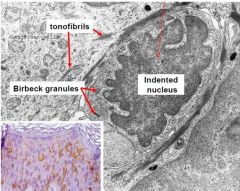
What cell is this?
What is the thin red arrow pointing to? |
-Langerhan cells
-nucleus Note: Birbeck granules looks like paddles |
|

What cell is this?
What is the paddle looking structure (rod like structures with regular striations)? |
-Langerhan cells
-Birbeck granules |
|

What skin layer is this?
What are the two parts of this layer? What is the function of P? |
-dermis
-papillary layer (P) & reticular layer (R) -loose CT that interdigitates with epidermis (separated by basement membrane); contains collagen type I & III, elastic fibers, & anchoring fibrils that extend from basal lamina into papillary layer |
|
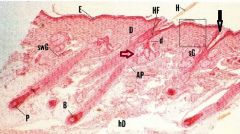
What layer is this?
What is the black arrow pointing to? What is the red arrow pointing to? What is HF? |
-reticular layer (dermis)
-arrector pilli -gland -hair follicle |
|

What is the structure labeled HF?
Is this thick or thin skin? What is the black arrow pointing to? What is the red arrow pointing to? |
-hair follicle that are elongated keratinized structures derived from invagination of the epidermal epithelium
-thin skin -dermis -hypodermis |
|

What is the red arrow pointing at (SG)?
What does SG secrete? What is its function? Where is it located? What is the black arrow pointing at? |
-sebaceous gland
-produces sebum (waxy texture) -aid in hair flexibility & help maintain proper skin texture -located all over the body, except palms, soles, & sides of feet) -arrector pilli |
|
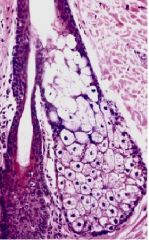
What structure is shown?
What type of secretion? What is the layer around the structure (darkly stained purple) What is this structure filled with? |
-sebaceous gland
-holocrine secretion (destruction of cell) -acinus (basal layer of undifferentiated flattened epithelial cells resting on basal lamina) --> cells are mitotically active -packed with lipid filled vacuole Note: vacuoles secreted & die --> mixed in with sebum |
|

What is the simple (coiled) tubular structure shown?
What is its function? |
-eccrine sweat gland
-ducts open on skin surface (sweat pores not associated with hairs) for temperature regulation |
|

What is this structure?
What is unique about nuclei? |
-eccrine sweat gland
-nuclei are round and located basally --> serous Note: Have adipose tissue on the upper right hand corner |
|

What is the red arrow pointing to?
What type of secretion? |
-eccrine sweat gland (invaginations of epithelium into dermis/hypodermis)
-merocrine secretion: aka regular exocytosis where cells are not damaged during secretion |
|

What is this structure?
What is unique about its feature? Where is it located? |
-apocrine sweat glands
-larger than eccrine sweat glands; larger lumen than eccrine sweat glands; secretory part stored in the lumen; odorless until metabolized by bacteria -situated in dermis & hypodermis; found in axilla, areola, & anal regions Note: Arise from epithelium of hair follicles; open into canal of hair follicles; becomes active @ puberty |

